
The Isle of Man TT or Tourist Trophy races are an annual motorcycle racing event run on the Isle of Man in May/June of most years since its inaugural race in 1907. The event is often called one of the most dangerous racing events in the world as many competitors have died.

The Norton Motorcycle Company is a brand of motorcycles, originally based in Birmingham, England. For some years around 1990, the rights to use the name on motorcycles was owned by North American financiers.

A. J. Stevens & Co. Ltd was a British automobile and motorcycle manufacturer in operation from 1909 to 1931. The company was founded by Joe Stevens in Wolverhampton, England. After the firm was sold, the name continued to be used by Matchless, Associated Motorcycles and Norton-Villiers on four-stroke motorcycles till 1969, and since the name's resale in 1974, on lightweight, two-stroke scramblers and today on small-capacity roadsters and cruisers. The company held 117 motorcycle world records.

Matchless is one of the oldest marques of British motorcycles, manufactured in Plumstead, London, between 1899 and 1966. A wide range of models were produced under the Matchless name, ranging from small two-strokes to 750 cc four-stroke twins. Matchless had a long history of racing success; a Matchless ridden by Charlie Collier won the first single-cylinder race in the first Isle of Man TT in 1907.

Phillip William Read, was an English professional motorcycle racer. He competed in Grand Prix motorcycle racing from 1961 to 1976. Read is notable for being the first competitor to win world championships in the 125 cc, 250 cc and 500 cc classes. Although he was often overshadowed by his contemporary, Mike Hailwood, he won seven FIM Grand Prix road racing world championships.

The Triumph Trident and BSA Rocket 3 was a technically advanced, high-performance roadster motorcycle made by Triumph Engineering and BSA from 1968 to 1975, and sold under both the Triumph and BSA marques. Alongside the Honda CB750, and later the Kawasaki triples, it brought a new level of sophistication to street motorcycles, marking the beginning of the superbike era. The Honda CB750 overshadowed the Trident to be remembered as the 'first superbike', in spite of the Triumph Trident actually debuting before the Honda by a few weeks.

The Norton Commando is a British Norton-Villiers motorcycle with an OHV pre-unit parallel-twin engine, produced by the Norton Motorcycle company from 1967 until 1977. Initially having a nominal 750 cc displacement, actually 745 cc (45.5 cu in), in 1973 it became an 850 cc, actually 828 cc (50.5 cu in). It had a hemi-type head, similar to all OHV Norton engines since the early 1920s.
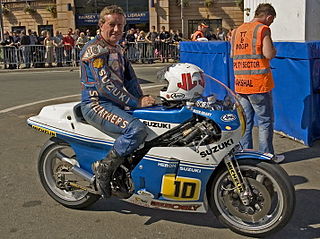
Mick Grant is an English former professional motorcycle road racer and TT rider. A works-supported rider for Norton, Kawasaki, Honda and Suzuki, he is a seven-time winner of the Isle of Man TT motorcycle race on various makes, including 'Slippery Sam', a three-cylinder Triumph Trident. The son of a coal miner, the soft-spoken, down-to-earth Yorkshireman from Wakefield, was a sharp contrast to the brash, playboy image presented by Londoner Barry Sheene during the 1970s.

Peter Williams was a British former professional motorcycle racer. He competed in Grand Prix motorcycle road racing from 1966 to 1973. He also competed at many levels on home short-circuit races. He raced many times on the Isle of Man TT course from 1966 to 1973. His father was Jack Williams who ran the Associated Motor Cycles (AMC) race department. Williams trained in mechanical engineering and introduced via racing alloy wheels, an innovation which is commonplace on today's road bikes, and was also an early pioneer of solo-motorcycle disc brakes.
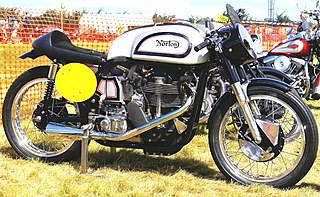
The Norton Manx or Manx Norton is a British racing motorcycle that was made from 1947 to 1962 by Norton Motors Ltd. Norton had contested every Isle of Man TT race from the inaugural 1907 event through into the 1970s, a feat unrivalled by any other manufacturer, and the development and honing of the Manx racing motorcycle was another step in this racing achievement.
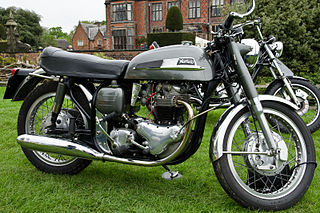
The Dominator is a twin cylinder motorcycle developed by Norton to compete against the Triumph Speed Twin. The original Dominator was designed in 1947 and 1948 by Bert Hopwood, who had been on the Speed Twin design team at Triumph. Available for sale from mid 1949, this design set the pattern for Norton twins for the next 30 years.

The featherbed frame was a motorcycle frame invented by the McCandless brothers and offered to the British Norton motorcycle company to improve the performance of their racing motorcycles in 1950. It was considered revolutionary at the time, and the best handling frame that a racer could have. Later adopted for Norton production motorcycles, it was also widely used by builders of custom hybrids such as the Triton, becoming legendary and remaining influential to this day.
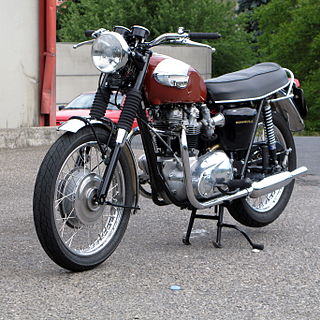
The Triumph Bonneville T120 is a motorcycle originally made by Triumph Engineering from 1959 to 1975. It was the first model of the Bonneville series, which was continued by Triumph Motorcycles Ltd. The T120 was discontinued in favour of the larger 750 cc T140 in the early 1970s.
Percy Tait was an English professional motorcycle road racer and senior road tester for Triumph motorcycles, where he was estimated to have covered over a million miles of road testing. He later became a farmer specialising in award-winning rare breeds of sheep.

The Dunstall Norton was a Norton motorcycle made by Paul Dunstall, a specialist tuner of the 1960s and early 1970s twins originally using some parts from Norton's Domiracer project when the Birmingham factory was closed in 1963. In 1966 Dunstall Motorcycles became a motorcycle manufacturer in its own right so that Dunstalls could compete in production races, and set a number of world records before sales of the Dunstall Nortons declined in the 1970s consistent with the demise of the British motor cycle industry and a corresponding rise in Japanese imports.
Colin Jordan Seeley was a British motorcycle retailer who later became a motorcycle sidecar racer, motorcycle designer, constructor and retailer of accessories. In 1992 he was involved in running the Norton Rotary race team.
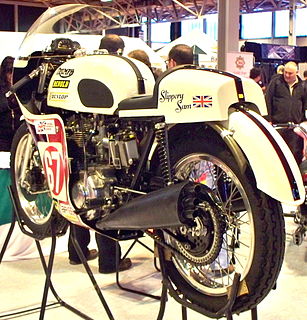
Slippery Sam is a British production class racing motorcycle from the early 1970s that used a carefully prepared version of the 750 cc Triumph Trident ohv (pushrod) three-cylinder engine. The "Slippery Sam" name was acquired during the 1970 Bol d'Or, a 24-hour race for production-based machines held in France, when engine difficulties and escaping oil covered the bike of Triumph employee Percy Tait and co-rider Steve Jolly who managed to finish in fifth place to winners Paul Smart and Tom Dickie on another works Trident.

BSA motorcycles were made by the Birmingham Small Arms Company Limited (BSA), which was a major British industrial combine, a group of businesses manufacturing military and sporting firearms; bicycles; motorcycles; cars; buses and bodies; steel; iron castings; hand, power, and machine tools; coal cleaning and handling plants; sintered metals; and hard chrome process.
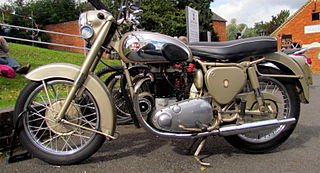
The BSA A10 series was a range of 646 cc (39.4 cu in) air-cooled parallel twin motorcycles designed by Bert Hopwood and produced by Birmingham Small Arms Company at Small Heath, Birmingham from 1950 to 1963. The series was succeeded by the A65 unit construction models.
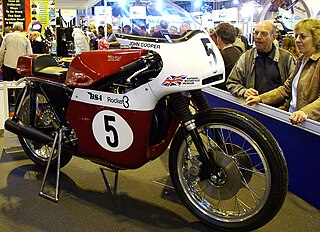
The BSA/Triumph racing triples were three cylinder 750 cc racing motorcycles manufactured by BSA/Triumph and raced with factory support from 1969-1974. There were road racing, production racing, endurance racing and flat track variants. The machines were based on the road-going BSA Rocket 3/Triumph Trident.




















